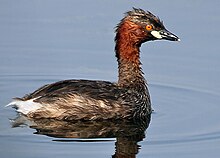Tachybaptus
| Tachybaptus | |
|---|---|

| |
| Tachybaptus ruficollis in Hyderabad, India. | |
| Scientific classification | |
| Domain: | Eukaryota |
| Kingdom: | Animalia |
| Phylum: | Chordata |
| Class: | Aves |
| Order: | Podicipediformes |
| Family: | Podicipedidae |
| Tribe: | Podilymbini |
| Genus: | Tachybaptus Reichenbach, 1853 |
| Type species | |
| Colymbus minor[1] Gmelin, 1789
| |
| Species | |
|
See text. | |
| Synonyms | |
| |
Tachybaptus is a genus of small birds of the grebe family. The genus name means "quick diving": it is from Ancient Greek takhys "quick" and bapto "I dip".[2] It has representatives over much of the world, including the tropics.
These grebes breed in small colonies in heavily vegetated areas of freshwater lakes. They may move to more open or coastal waters when not breeding, and birds in those areas where the waters freeze may be migratory. Like all grebes, they nest on the water's edge, since the legs are set very far back and they cannot walk well. The striped young are sometimes carried on the adult's back. These small grebes are excellent swimmers and divers, and pursue their fish prey underwater.
The sexes are similar: dumpy and short-billed with a “powder puff” rear end. Adults have a distinctive breeding plumage and loud breeding calls. In winter, they are grey and white.
The five Old World species are closely related to each and at least three have interbred. Unlike these, the least grebe lacks chestnut colouring on the neck, and has formerly been placed in at least three other genera.
Species
| Image | Scientific name | Common name | Subspecies | Distribution |
|---|---|---|---|---|
 |
Tachybaptus ruficollis (Pallas 1764) | Little grebe |
|
Across Europe, much of Asia down to New Guinea, and most of Africa |
| Tachybaptus tricolor (Gray 1861)[3] | Tricolored grebe |
|
Sulawesi, North Maluku to New Guinea, Java, Timor, Lesser Sundas, to Bougainville Island. | |
 |
Tachybaptus novaehollandiae (Stephens 1826) | Australasian grebe |
|
Greater Australia, New Zealand and nearby Pacific islands. |
 |
Tachybaptus pelzelnii (Hartlaub 1861) | Madagascar grebe | Western and central Madagascar. | |
 |
Tachybaptus rufolavatus (Delacour 1932) (extinct: last seen in 1985, declared extinct in 2010)[4][5] |
Alaotra grebe (rusty grebe) | Lake Alaotra and its surrounding lakes in Madagascar. | |
 |
Tachybaptus dominicus (Linnaeus 1766) | Least grebe |
|
Southern United States and Mexico to Argentina; also Trinidad and Tobago, the Bahamas and the Greater Antilles. |
References
- ^ "Podicipedidae". aviansystematics.org. The Trust for Avian Systematics. Retrieved 2023-08-05.
- ^ Jobling, James A (2010). The Helm Dictionary of Scientific Bird Names. London: Christopher Helm. p. 377. ISBN 978-1-4081-2501-4.
- ^ "Grebes". International Ornithological Congress. Retrieved 2015-01-06.
- ^ BirdLife International (2010) Species factsheet: Tachybaptus rufolavatus. Downloaded from http://www.birdlife.org on 26/5/2010
- ^ BirdLife International (2010). Wetland aliens cause bird extinction. Downloaded on 26 May 2010 from http://www.birdlife.org/news/news/2010/05/red-list-for-birds-2010.html
- Olgilvie and Rose, Grebes of the World ISBN 1-872842-03-8
- Harrison, Peter Seabirds: An Identification Guide ISBN 0-7470-1410-8


